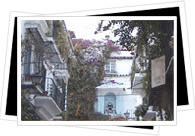Marbella owes a lot of its history and culture to the Moors – this fact is very much evident in the numerous houses, buildings, towers and plazas that bear the Moorish mark. Marbella is one of the repositories of Moorish culture in Spain. There are Moorish ramparts and buttresses, which include a castle. 
We also find the Plaza de Los Naranjos, which is also reminiscent of Moorish town squares, particularly with its whitewashed houses. It is also in the Old Quarter, right at its very heart, that we can see the remains of the Las Murallas del Castillo, or the Arab castle along with its city walls. These walls were once spread over 90000 square meters of land. It was constructed during the Caliph period (10th century) but was later expanded by the Nazaries (14th century). You can readily see the traces of the once beautiful building, but it is, sadly, ravaged by time. However, part of the castle and the walls are currently being rebuilt.
Meanwhile, the Town Hall in the Plaza de los Naranjos features an upper floor ceiling carved in the Mudejar style, which is essentially inspired by Moorish design and architecture – an architectural style developed by Muslims living in Christian areas. On its façade, in the upper right hand corner are some shields and stone inscriptions. One of these date back to 1485 and commemorates the re-conquest of Marbella by the Moors.
In the Parque de la Constitution, you will find Moorish-style buildings interspersed with typical Mediterranean flora. This forms an ideal setting for concerts and ballet performances during the summer season.
Add to this the former Hospital of the Incarnation of Bazan, which now houses the Contemporary Engraving Museum. The Hospital de Bazan is named after Alonso Bazan, the mayor of the city and of Castillo and the former resident of the building. It has an asymmetric design, which is mainly because of the fact the base stands over three Moorish houses, and as such, the base used this foundation as its pattern. Currently, the Hospital de Bazan has Renaissance, Moorish and Gothic elements in it.
Another structure that bears the Moorish influence is the Real de la Misericordia or De San Juan de Dios Hospital. This building bears Mudejar elements. The roof of the hospital chapel has a fascinating feature – Mudejar Armor. However, this building also incorporates Gothic and Renaissance elements.
There are also two towers that are thought of as Muslim or Moorish in origin – the Torre de Ladrones Tower and the Torre Del Duque. The Ladrones Tower is one of the first Almenera towers within Marbella. It is to be found near the port of Cabopino. It is named after the projections that are called Ladroneras in Spanish. It is believed to have Moorish influence because of its shape, the materials used and the way it was used. It is a cone-shaped building, 3.65 meters in width and 14.6 meter in height, with three rooms and a terrace. Meanwhile theTorre del Duque is a prism-shaped tower made of stone and brick. It is 4.2 meters wide and 10 meters high. Its door rises 7.2 meters from the ground. It is located near the main entrance of Puerto Banus and it is named after the Duke of Cadiz and Arcos, Don Rodrigo Ponce de Leon. The duke was a counselor to the Catholic Kings.